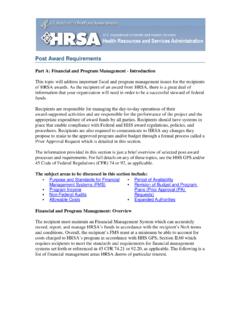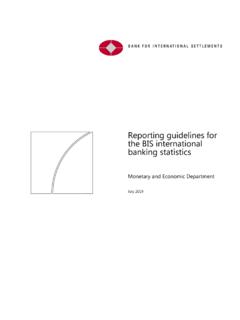Transcription of U. S. Department of Health and Human Services Health ...
1 PPEERRFFOORRMMAANNCCEE MMAANNAAGGEEMMEENNTT AANNDD MMEEAASSUURREEMMEENNTT U. S. Department of Health and Human Services Health Resources and Services Administration April 2011 Performance Management and Measurement Contents PERFORMANCE MANAGEMENT AND MEASUREMENT .. 1 Part 1: Overview .. 1 Introduction .. 1 What Is Performance Measurement? .. 2 Why Does an Organization Need to Measure Performance? .. 2 Types of Performance Measures .. 3 Performance Management .. 3 Part 2: Performance Management Process [bookmark].. 5 Step 1: Evaluate Organizational Priorities .. 7 Step 2: Choose Performance Measures .. 8 Step 3: Determine a Baseline .. 9 Step 4: Evaluate Performance .. 11 Step 5: Develop a Plan and Make Changes to Improve Performance.
2 13 Step 6: Monitor Performance Over Time .. 14 Part 3: Case Story .. 14 Part 4: References .. 14 Part 5: Additional Resources .. 15 June 26, 2012 i Performance Management and Measurement PERFORMANCE MANAGEMENT AND MEASUREMENT The purpose of this module is to introduce the fundamental concepts of performance management and assist an organization to develop a practical strategy for achieving its quality improvement (QI) goals. This module highlights the use of evidence-based performance measures to set QI goals and evaluate an organization s progress in meeting them . Part 1: Overview Introduction Since accountability for performance has become increasingly critical in Health care, it is necessary for an organization to understand the key drivers behind its performance and demonstrate the results of its work.
3 Performance measurement has many interrelationships with quality improvement (QI), and focus on the use of the data is one of the four key principles of QI discussed in the Quality Improvement module. Data used for measuring performance provides evidence of how well an organization s system is working currently and what happens when changes are applied. Performance measurement data and QI also support and maximize the usefulness of QI tools. Three important concepts are defined as foundational to a QI data infrastructure: Performance measures are designed to measure systems of care and are derived from clinical or practice guidelines. Data that is defined into specific measurable elements provides an organization with a meter to measure the quality of its care. Performance measurement is a process by which an organization monitors important aspects of its programs, systems, and processes.
4 In this context, performance measurement includes the operational processes used to collect data necessary for the performance measures. Performance management is a forward-looking process used to set goals and regularly check progress toward achieving those goals. In practice, an organization sets goals, looks at the actual data for its performance measures, and acts on results to improve the performance toward its goals. Performance measures should be distinguished from clinical guidelines. Clinical or Practice guidelines are systemically-developed statements to assist practitioners and patients in making decisions about appropriate Health care for specific clinical circumstances. Attributes of good guidelines include validity, reliability, reproducibility, clinical applicability, clarity, multidisciplinary process, review of evidence and documentation.
5 (1) Performance measures provide an indication of an organization's performance in relation to a specified process or outcome. Practice guidelines that outline the expectations of care around a specific issue or disease state are created by a group of subject matter or clinical experts. Because performance measures and standards of care each serve a different purpose, they are not always identical. June 26, 2012 1 Perf ormance Management and Measurement This module describes in detail why performance measurement is important and provides a step-by-step guide for the performance management process. What Is Performance Measurement? Performance measurement is a process by which an organization monitors important aspects of its programs, systems, and care processes.
6 Data is collected to reflect how its processes are working, and that information is used to drive an organization s decisions over time. Typically, performance is measured and compared to organizational goals and objectives. Results of performance measurement provide information on how an organization s current programs are working and how its resources can be allocated to optimize the programs efficiencies and effectiveness. Performance measurement is well established throughout Health care in the core areas of finance, operations, and clinical care Services . For example: Finance an organization often measures the efficiency of its accounts receivables (AR); , timely collection of payment for Services rendered Operations an organization tracks the length of time it takes for a patient to receive an appointment in the practice, or measures patient satisfaction with the care received Clinical Care an organization measures how often care is delivered in accordance with evidence-based guidelines, or how effective that care is in improving patient outcomes There are other examples of performance measurement in Health care organizations today.
7 As information technology is widely integrated into Health care settings, support for performance measurement will also expand throughout the organization. Why Does an Organization Need to Measure Performance? There are a number of reasons why an organization may choose to measure its performance. Performance measurement provides a reliable process to determine if an organization s current system is working well. Also in today s economy, there is a demand for transparency and increasing scrutiny of an organization s business practices. These reasons promote an organization s use of process and outcome data as a means to demonstrate its performance. There are other typical circumstances of why an organization may choose to measure its performance, such as: Distinguish what appears to be happening from what is really happening Establish a baseline.
8 , measure before improvements are made Make decisions based on solid evidence Demonstrate that changes lead to improvements Allow performance comparisons across sites Monitor process changes to ensure improvements are sustained over time Recognize improved performance 2 Perf ormance Management and Measurement There are additional motives for a Health care organization to measure its performance: Government-accrediting organizations and funding sources rely on performance measurement to prove resources are used effectively and efficiently Clinicians use performance measurement to quantify the effectiveness of evidence-based care provided by their care delivery systems Organizational leaders use performance measurement to monitor and improve management, clinical care, and support Services Fund raising is increasingly tied to documented performance Types of Performance Measures It is useful to categorize performance measures to better understand what systems or processes are measured.
9 An organization may combine different types of measures to provide a complete picture of its underlying systems. There are four types of performance measures: Process measure quantifies a Health care service provided to, on behalf of, or by a patient, that is based on scientific evidence of efficacy or effectiveness. (2) It quantifies a specific system; , to get a test done or a service performed. Outcome measure quantifies a patient s Health status resulting from Health care. (2) In the clinical area, it often measures a patient outcome so it can be compared to a care standard, such as, a patient s test value. Balancing measure ensures that changes to improve one part of the system are not causing new problems in other parts of the system. (3) It examines another part of the system to ensure that improvements in one area have no unexpected consequences in another.
10 Structure of care measure quantifies a feature of a Health care organization (or clinician) relevant to its capacity to provide Health care. (2) Performance Management Performance management is a process for set ting goals and regularly checking progress toward achieving those goals. It includes activities that ensure organizational goals are consistently met in an effective and efficient manner. The overall goal of performance management is to ensure that an organization and its subsystems (processes, departments, teams, etc.), are optimally working together to achieve the results desired by the organization. Performance management has a wide variety of applications, such as, staff performance, business performance, or in Health care, Health outcome performance measures. Because performance management strives to align all the subsystems to achieve results, the focus of performance management should also affect the management of an organization s performance overall.












